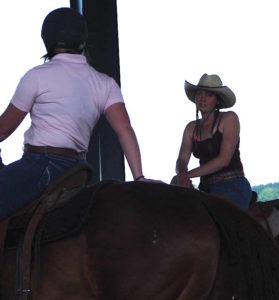Amy Skinner is a regular guest columnist and has been a horse gal since age six. She runs Essence Horsemanship, rides and teaches English and Western. Skinner has  studied at the Royal Andalusian School of Equestrian Art in Spain, with Buck Brannaman, Leslie Desmond, Brent Graef, and many others.
studied at the Royal Andalusian School of Equestrian Art in Spain, with Buck Brannaman, Leslie Desmond, Brent Graef, and many others.
Read more about Amy here.
By Amy Skinner
Usually after a clinic, I feel energized, encouraged and excited. The energy from a group of people making changes, learning, and discovering gives me a feeling of hope that carries me forward despite the junk that prevails in the horse industry. I’m honored to be part of people helping each other, helping their horses and helping themselves.
Sometimes after a clinic, though, I feel drained. Some moments demand my all. The moment asks me to reach deep inside and give everything I have physically and emotionally. It can be very personal and I may need to give a lot of myself to prove a point or help someone on their journey.
I have cried with people, listening to stories that have nothing to do with horses. But they really they do. This journey toward working with the horse in lightness is really about changing our lives.
I’ve had to pull up things inside myself that weren’t pretty or enjoyable in order to relate to students’ struggles. We revisit challenges in order to become better people. Being a better person means being a better horse person.
 From time to time, I meet someone who doesn’t understand the value in this journey. I don’t want people learning “my” method or becoming Amy Skinner “followers.” I’m interested in presenting things in a way that makes sense to the horse. What I’m offering in a lesson or a clinic doesn’t come from me. It comes from the horse and from my human interpretation. It’s an understanding of the horse and what it needs.
From time to time, I meet someone who doesn’t understand the value in this journey. I don’t want people learning “my” method or becoming Amy Skinner “followers.” I’m interested in presenting things in a way that makes sense to the horse. What I’m offering in a lesson or a clinic doesn’t come from me. It comes from the horse and from my human interpretation. It’s an understanding of the horse and what it needs.
My mare was once ridden in a “B.O.B” (Big Ol’ Bit). She gaped at the mouth to avoid it. She was put in a flash noseband to keep her mouth shut. After she couldn’t avoid the bit by opening her mouth, she began tossing her head up. She was then equipped with a nice, short martingale to keep her head down.
All this gear created a racing, forehand-heavy, pissed-off horse with the most overdeveloped under-neck I’ve ever seen. She was ready to kill the world, upset, frustrated, scared, and dangerous. She’d been shut down, disregarded as an intelligent being with a high sense of self-preservation.
In comes “horsemanship to the rescue.” I presented a snaffle bit. Does she run through that bit? You bet.
Most importantly, what needed fixing was her idea of how to operate in relation to the equipment and the rider working it. I had to teach her that I wasn’t going to argue with her. I would wait patiently until she made correct choices.
Yes, it took years. She may never feel as nice or light as a horse started in a way that it could understand. But it was worth it. She’s an incredible horse.
I was recently asked, “what’s wrong with covering up the symptoms?”
Bigger bits don’t solve the root problem. They mask the symptoms and only for a while.
- Restrictive gear treats the horse as a “thing” instead of a creature with thoughts and feelings and needs.
- It often puts the horse in physical pain with lasting consequences. My mare has limited range of motion in her back, fetlocks, and neck and has fused hocks.
- The horse is prevented from developing to its full potential. It cannot work in balance in its body, develop correctly as an athlete, or develop a healthy relationship with the rider.
These reasons may be enough for you. But the biggest reason for steering clear of restrictive gear is safety:
A horse trained to push through pressure and pain responses is an unsafe horse. One who responds regularly out of fear cannot be reliable; fear becomes its only focus. The rest of the world becomes drowned out.
The only truly safe horse is one who is mentally relaxed and taught to connect with the rider or handler because it feels safe. If you’re working toward creating a partner who doesn’t operate routinely in fear, the possibilities go beyond a light, enjoyable ride. You can create a partner, and the things the horse is willing to give back can be truly humbling and incredible.

Wow. And thank you.